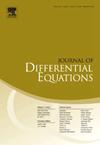Normalized solutions for a nonlinear Dirac equation
IF 2.4
2区 数学
Q1 MATHEMATICS
引用次数: 0
Abstract
We prove the existence of a normalized, stationary solution with frequency of the nonlinear Dirac equation. The result covers the case in which the nonlinearity is the gradient of a function of the form with , and sufficiently small. Here , are the Dirac's matrices.
We find the solution as a critical point of a suitable functional restricted to the unit sphere in , and ω turns out to be the corresponding Lagrange multiplier.
非线性狄拉克方程的归一化解
我们证明了非线性狄拉克方程存在一个频率为 ω>0 的归一化静止解 ψ:R3→C4。结果涵盖了这样一种情况:非线性是形式为F(Ψ)=a|(Ψ,γ0Ψ)|α2+b|(Ψ,γ1γ2γ3Ψ)|α2的函数的梯度,α∈(2,83],b≥0且a>0足够小。这里 γi, i=0,..., 3 是 4×4 的狄拉克矩阵。我们发现解是限制在 L2 单位球内的合适函数的临界点,而 ω 就是相应的拉格朗日乘数。
本文章由计算机程序翻译,如有差异,请以英文原文为准。
求助全文
约1分钟内获得全文
求助全文
来源期刊
CiteScore
4.40
自引率
8.30%
发文量
543
审稿时长
9 months
期刊介绍:
The Journal of Differential Equations is concerned with the theory and the application of differential equations. The articles published are addressed not only to mathematicians but also to those engineers, physicists, and other scientists for whom differential equations are valuable research tools.
Research Areas Include:
• Mathematical control theory
• Ordinary differential equations
• Partial differential equations
• Stochastic differential equations
• Topological dynamics
• Related topics

 求助内容:
求助内容: 应助结果提醒方式:
应助结果提醒方式:


